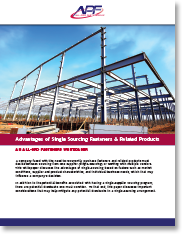Any decision to enter into a single-source relationship is of significant strategic importance to both the buying organization and the supplier, and this decision can depend on various (and sometimes unique) factors of doing business. While all circumstances are different, there are factors that should be considered when evaluating the efficacy of a proposed single-source arrangement.

What Efficiencies Can Be Achieved
Would single-sourcing help to make the purchasing, sales, manufacturing, distribution and/or accounting processes more efficient for one or both parties? If so, the economic incentives for entering a single-source arrangement can be compelling. How well these efficiencies can be structured for the mutual benefit of both parties can determine the long-term efficacy of the single-source relationship. These efficiencies can lead to benefits such as lower costs, increased profitability, and reduced overhead for one or both parties.
Benefits vs. Downsides
The benefits of any single-source solution under consideration must clearly outweigh any potential downsides. An in-depth analysis allows the procurement team to compare the benefits and potential downsides of the proposed single-source relationship, in order to make a determination based on all considerations. Does the vendor offer higher quality products, or superior lead times, that are critical to the buyer’s success in the marketplace? Do they offer innovative logistics solutions that reduce the costs of going to market? If the benefits offered by the supplier represent a significant upside to the buying organization, compared to potential downsides, then a single-source approach to procurement is a potentially advantageous approach.
Supplier Troubleshooting and Backup Plans
Does the vendor have troubleshooting plans in place in case of emergency? Can production be shifted to another facility in the event of a disruption? Does the vendor have access to multiple sub-suppliers if the prime supplier is unable to meet demand? Are backup plans in place to guard against potential outages? By understanding the ins-and-outs of the supplier’s operations and engaging in the necessary dialog to ascertain the details, the buying organization can help protect itself, and ensure proper due diligence has been conducted to lay the groundwork for success.
Size of the Business
Is the business large enough to allow the supplier to realize efficiencies that can be passed on to the buying organization? Is the business too large to make single-sourcing feasible? By analyzing the production capacities of the supplier, both parties can ensure the single-source approach can be balanced, practical and economically workable for both parties.
Services Required
If specific or specialized services will be required of the potential vendor(s), this will also be a major factor in evaluating the feasibility and value of a single-source option. For example, if special packing, specialized distribution, customized paperwork or special delivery requirements will be part of the requirements, potential vendors must be screened accordingly. Are Vendor Managed Inventory (VMI) services required? Are special testing procedures on critical parts necessary for the items produced? Before deciding on a single-source solution, it is important to define the specific services that are required on each product that is to be delivered and evaluate the ability of the supplier to meet the requirements.
Contingency Plans & Other Considerations
When evaluating the use of single vendor sourcing many procurement managers become very concerned about their risk exposure and are seeking options to mitigate risk. Mutual dependency or partnerships is key so that both sides will regard the relationship with high importance. In this instance both the vendor and the buyer are motivated to improve quality, reduce costs, and improve designs.
Other considerations include the presence of prior commitments on the part of the buyer or supplier, successful past relationships between the prospective parties, or the existence of ongoing relationships between the parties and/or competitive organizations.



 All-Pro Fasteners seeks to create mutually beneficial, advantageous and prosperous relationships with its customer partners. In most cases, each company has a successful procurement process in place that supports single-sourcing or multiple-sourcing. Our goal is to expand on our partners’ success by being flexible to their needs.
All-Pro Fasteners seeks to create mutually beneficial, advantageous and prosperous relationships with its customer partners. In most cases, each company has a successful procurement process in place that supports single-sourcing or multiple-sourcing. Our goal is to expand on our partners’ success by being flexible to their needs. Managing demand fluctuations.
Managing demand fluctuations.